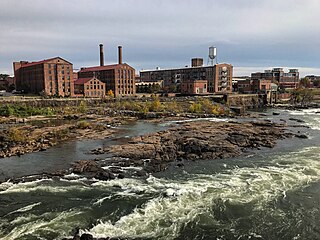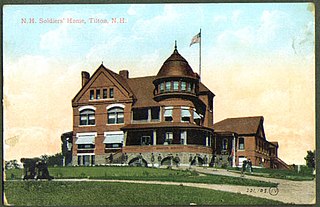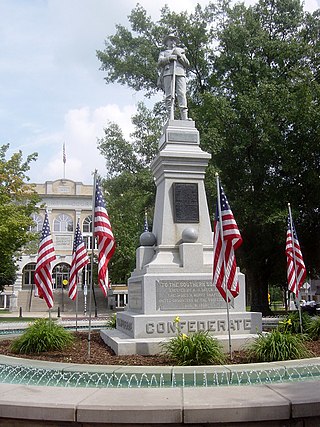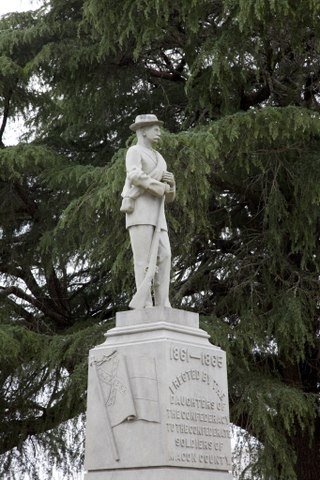
Memorial Day is a federal holiday in the United States for honoring and mourning the U.S. military personnel who died while serving in the United States Armed Forces. From 1868 to 1970, it was observed on May 30. Since 1971, it is observed on the last Monday of May.

Columbus is a consolidated city-county located on the west-central border of the U.S. state of Georgia. Columbus lies on the Chattahoochee River directly across from Phenix City, Alabama. It is the county seat of Muscogee County, with which it officially merged in 1970. Columbus is the second most populous city in Georgia, and fields the state's fourth-largest metropolitan area. At the 2020 census, Columbus had a population of 206,922, with 328,883 in the Columbus metropolitan area. The metro area joins the nearby Alabama cities of Auburn and Opelika to form the Columbus–Auburn–Opelika Combined Statistical Area, which had an estimated population of 486,645 in 2019.

An old soldiers' home is a military veterans' retirement home, nursing home, or hospital, or sometimes an institution for the care of the widows and orphans of a nation's soldiers, sailors, and marines, etc.

John Pelham was a Confederate cavalry soldier under J. E. B. Stuart during the American Civil War. Robert E. Lee called Pelham "The Gallant Pelham" for his use of light artillery at the Battle of Fredericksburg to delay U.S. soldiers.

Indian Mound Cemetery is a cemetery located along the Northwestern Turnpike on a promontory of the "Yellow Banks" overlooking the South Branch Potomac River and Mill Creek Mountain in Romney, West Virginia, United States. The cemetery is centered on a Hopewellian mound, known as the Romney Indian Mound. Indian Mound Cemetery is also the site of Fort Pearsall, the Confederate Memorial, Parsons Bell Tower, and reinterments from Romney's Old Presbyterian Cemetery. The cemetery is currently owned and maintained by the Indian Mound Cemetery Association, Inc.

Camp Chase was a military staging and training camp established in Columbus, Ohio in May 1861 after the start of the American Civil War. It also included a large Union-operated prison camp for Confederate prisoners during the American Civil War.
The Confederate Memorial State Historic Site is a state-owned property occupying approximately 135 acres (55 ha) near Higginsville, Missouri. From 1891 to 1950, the site was used as an old soldiers' home for veterans of the Confederate States Army after the American Civil War. The Missouri state government then took over operation of the site after the last veteran died in 1950, using it as a state park. In 1981, a cottage, a chapel, and the Confederate cemetery were listed on the National Register of Historic Places as the Confederate Chapel, Cemetery and Cottage. The chapel was moved from its original position in 1913, but was returned in 1978. It has a tower and a stained glass window. The cottage is a small wooden building, and the cemetery contains 723 graves. Within the cemetery is a monument erected by the United Daughters of the Confederacy which is modeled on the Lion of Lucerne. In addition to the cemetery and historic structures, the grounds also contain trails, picnic sites, and fishing ponds.

Confederate Memorial Park is an Alabama State Park located in Mountain Creek, in rural Chilton County, Alabama, United States. Its address is 437 County Road 63, Marbury, Alabama 36051. It is sometimes found with the same address in Verbena, Alabama 36091.

Loudon Park Cemetery is a historic cemetery in Baltimore, Maryland. It was incorporated on January 27, 1853, on 100 acres (40 ha) of the site of the "Loudon" estate, previously owned by James Carey, a local merchant and politician. The entrance to the cemetery is located at 3620 Wilkens Avenue.

Marietta Confederate Cemetery is a large Confederate cemetery located in Marietta, Georgia, adjacent to the larger Marietta City Cemetery.

A Ladies' Memorial Association (LMA) is a type of organization for women that sprang up all over the American South in the years after the American Civil War. Typically, these were organizations by and for women, whose goal was to raise monuments in Confederate soldiers honor. Their immediate goal, of providing decent burial for soldiers, was joined with the desire to commemorate the sacrifices of Southerners and to propagate the Lost Cause of the Confederacy. Between 1865 and 1900, these associations were a formidable force in Southern culture, establishing cemeteries and raising large monuments often in very conspicuous places, and helped unite white Southerners in an ideology at once therapeutic and political.

The Bentonville Confederate Monument was installed in Bentonville, Arkansas, United States. It was removed in September 2020.
The Civil War Trust's Civil War Discovery Trail is a heritage tourism program that links more than 600 U.S. Civil War sites in more than 30 states. The program is one of the White House Millennium Council's sixteen flagship National Millennium Trails. Sites on the trail include battlefields, museums, historic sites, forts and cemeteries.

Old Live Oak Cemetery is a historic cemetery in Selma, Alabama founded in 1829 and expanded in 1877. The newer portion is sometimes called New Live Oak Cemetery and the cemetery is collectively known as Live Oak Cemetery. It contains burials of Confederate States of America leaders, as well Benjamin Sterling Turner, a formerly enslaved African-American who served as U.S. Representative for Alabama during the Reconstruction era. The cemetery is at 110 Dallas Avenue approximately 0.7 miles (1.1 km) west of downtown Selma.

More than 160 monuments and memorials to the Confederate States of America and associated figures have been removed from public spaces in the United States, all but five since 2015. Some have been removed by state and local governments; others have been torn down by protestors.

The Tuskegee Confederate Monument, also known as the Macon County Confederate Memorial and Tuskegee Confederate Memorial, is an outdoor Confederate memorial in Tuskegee, Alabama, in the United States. It was erected in 1906 by the United Daughters of the Confederacy to commemorate the Confederate soldiers from Macon County, Alabama.

















